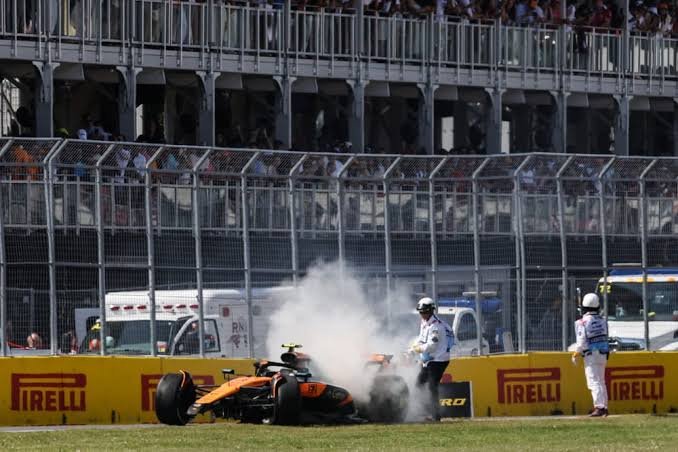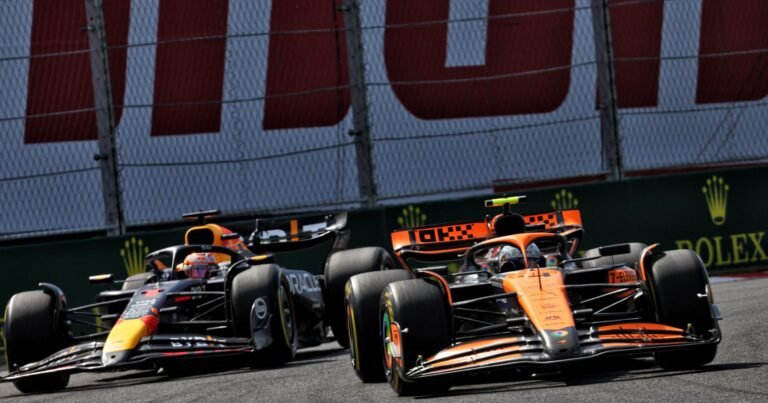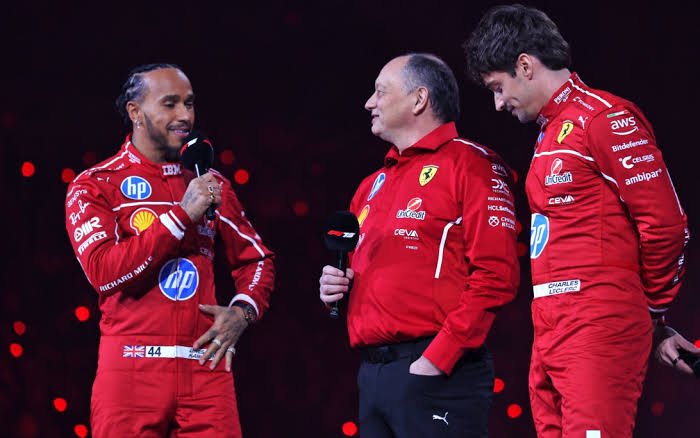
The McLaren F1 championship battle escalated in Canada last weekend when Lando Norris and Oscar Piastri crashed into each other.
McLaren team principal Andrea Stella has ruled out the use of team orders for its drivers after their clash at the Canadian Grand Prix.
Lando Norris crashed into the back of Oscar Piastri’s car during the Montreal race while competing for position, causing irreparable damage for the former.
Norris admitted he was at fault for the event, leading to Piastri increasing his championship lead to 22 points.
The two main characters have maintained a harmonious relationship thus far, with the Canada incident being the first point of conflict between them.
However, McLaren aims to put in place steps to prevent it from occurring again; Stella emphasized that this will not involve limiting the drivers from competing.
“Having the freedom to race and understanding the guidelines of racing is a core value,” Stella stated to reporters, including RacingNews365.
“It’s a principle of racing that we aim to uphold and honor as much as possible.”
“Instead of having control from the pit wall each time the two cars are close to each other.” “[Racing] in that manner, racing could quickly turn into somewhat of a relic.”
The McLaren pair are the obvious frontrunners for the F1 championship this season, with the Woking team claiming victory in seven of the 10 races held so far.
Stella mentioned that McLaren is cautious about the risks involved in meddling with the title battle as both Norris and Piastri compete for their initial F1 championship.
“We aim to provide Lando and Oscar with chances to race and to ultimately be in the position they merit at the end of the season, depending on their performance and the racing quality they have demonstrated throughout the season,” Stella stated.
“Instead of reaching the season’s conclusion and noticing that the team has influenced the points more than the skill of their driving.”
This is not inherently an easy or straightforward task, but we aim to approach it in the best way possible.
“I don’t expect the [Canadian] incident to alter our perspective in this regard – if anything, it will further emphasize that the principles we uphold necessitate greater caution from our drivers.”
“To ensure there is no contact between the two McLarens, we must have the necessary margins to guarantee no contact occurs.”
“Even in a DRS scenario, the car can be drawn almost a little toward the other car, leading to this type of miscalculation regarding the distance.”
The Canadian Grand Prix incident marked a pivotal moment in McLaren’s 2025 Formula 1 campaign. With both drivers firmly in contention for the world championship, tensions naturally rise as the season progresses. However, the team has made a conscious decision not to allow the pressure of a title fight to compromise their long-standing commitment to fair racing.
The clash, which occurred midway through the Montreal race, was the result of a tight on-track battle. As Norris attempted to overtake Piastri, he misjudged the closing speed and made contact with the rear of his teammate’s car. The damage forced Norris to retire, while Piastri went on to secure crucial points — further extending his lead in the driver standings.
Norris, who was quick to accept responsibility, expressed regret over the incident but emphasized that it was a racing mistake made in the heat of competition. Despite the setback, both drivers have reportedly moved on professionally, with no lingering animosity. This is significant, considering how rare it is for intra-team rivalries to remain civil during a high-stakes championship battle.
Stella’s comments about avoiding pit wall micromanagement reflect a broader philosophy within McLaren: to let the racing happen naturally, within reasonable safety and sportsmanship limits. His view that racing “could quickly turn into somewhat of a relic” if teams become overly controlling signals a deep respect for the sport’s roots, where driver skill and racecraft are paramount.
To that end, McLaren’s technical and managerial staff are reportedly working on refining internal protocols that ensure both drivers have a clear understanding of racing conduct — particularly in close-quarter battles. These protocols won’t take the form of strict team orders, but rather clearer racing boundaries designed to avoid unnecessary incidents.
This is a delicate balance to strike. On one hand, there is a strong desire to preserve the spirit of competition; on the other, McLaren cannot afford repeated clashes between its drivers if it hopes to win both the Constructors’ and Drivers’ Championships. Stella admitted that while McLaren respects racing freedom, that freedom comes with a duty of care — both to the team and to each other as drivers.
“We don’t want a scenario where the team plays a more decisive role than the drivers in how the championship unfolds,” he said. “It must be based on merit — on track performance, race strategy, and the drivers’ ability to handle the pressures of competition.”
The Woking-based outfit has enjoyed a remarkable season so far. With seven wins out of 10 races, McLaren has firmly established itself as the team to beat. Much of this success can be attributed to the performance gains made in both the chassis and power unit departments, as well as the synergy between Norris and Piastri — who have emerged as one of the most competitive driver pairings on the grid.
That said, internal competition can quickly spiral into internal conflict if not properly managed. Formula 1 history is full of examples where strong teammates pushed each other — and their teams — to breaking point. From Senna-Prost to Hamilton-Rosberg, the risks of intra-team rivalry are well documented.
McLaren’s decision to avoid team orders for now speaks volumes about the trust it places in Norris and Piastri to race each other cleanly. It also signals confidence in their maturity and professionalism — even in the heat of a title fight. Still, the Canadian Grand Prix incident serves as a cautionary tale and a reminder that the margins in F1 are razor-thin.
As the 2025 season continues, all eyes will be on how McLaren manages this dynamic. The team’s approach could set a precedent for how modern F1 teams balance intra-team rivalries with the overarching goal of winning championships.
For now, Stella remains steadfast in his philosophy: race hard, race fair, and let the best driver win — without interference from the pit wall.



